Schoonselhof is considered the most beautiful cemetery in Flanders. Many famous local personalities are buried in monumental tombs and ornate graves. There are also large sections with military graves.
History
Sconsele Farmstead


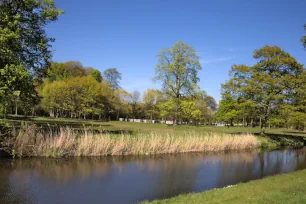
Schoonselhof wasn’t always a cemetery. The history of the domain goes back to the early twelfth century, when a farmstead known as Sconsele was located here. In 1544 Sconsele was purchased by the powerful Florentine financier Gaspar Ducci. From that time on, Schoonselhof became known as a “Hof van Plaisantie”, a summer retreat outside the city for the rich and famous. The property regularly changes hands and in 1779 the then owner, Marie Louise du Bois, builds the Schoonselhof Castle.
Schoonselhof becomes a Cemetery
The last owner of Schoonselhof was Julius Moretus, a scion of the famous printing family. When he dies in 1911, the city of Antwerp decides to purchase Schoonselhof and designates it as a cemetery. The cemetery officially opens in 1921 but the first person interred at Schoonselhof was a German soldier who was buried here on August 29, 1914, during the Germans’ siege of Antwerp.
The Cemetery
The cemetery covers an area of 85 hectares (210 acres), much of which is open space. In a sense, Schoonselhof, with its wide tree-lined lanes, its lawns, trees, creeks and ponds resembles more of a public park than a cemetery. Fauna and flora flourish here, and Schoonselhof is a welcome habitat for many birds, insects and amphibians.
Adding to the natural beauty of Schoonselhof is its picturesque castle, a stately edifice built in French classicist style and surrounded by a moat.
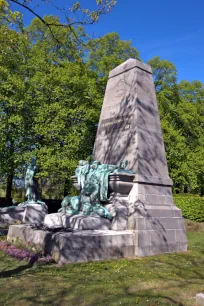
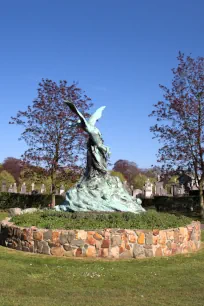
Monuments
But the main draw of Schoonselhof is its numerous funerary sculptures and monuments that were created over a period of more than two hundred years by some of the region’s leading artists and architects. The cemetery is the last resting place for politicians, local celebrities, wealthy citizens, and anyone who has made significant contributions to culture, arts or science.
One of the largest monuments on the cemetery grounds is the tomb of Hendrik Conscience, a writer ‘ who taught his people to read’ – he was one of the first to write novels in Flemish (despite having French ancestry). On his tomb rests a monumental lion statue, guarding a statue of the writer himself, who is depicted on his deathbed in front of a massive obelisk. The monument was created by Frans Joris and inaugurated in 1886.
Flemish composer and conductor Peter Benoit is also honored with a large monument. The circular bronze monument, created by Arthur Pierre, depicts an angel who lifts a singing woman from a pool of misery.
The largest monument at Schoonselhof is dedicated to Leopold de Wael, mayor of Antwerp from 1872 to 1892, a period in which the city of Antwerp expanded rapidly. His sarcophagus rests on a huge pedestal that is guarded by a bronze angel playing the trumpet in his praise. The tomb is the work of architect Eugène Geefs and his brother and sculptor Georges Geefs.
Old graves
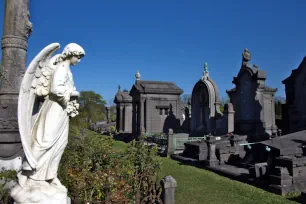

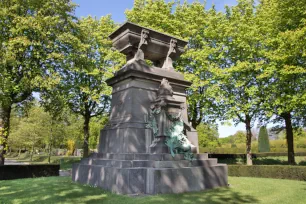
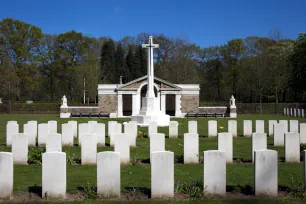
The large monuments were all created before Schoonselhof opened and originally resided at the Kiel Cemetery. When this cemetery closed in 1936, the monuments were moved to Schoonselhof.
Many other graves from the Kiel cemetery and from other cemeteries that closed were moved here and are grouped together in a section known as the ‘old graves’. This is one of the most picturesque areas of the cemetery, and virtually all graves here are adorned with statuary and reliefs. Besides large family tombs, you also encounter plenty of stelae and obelisks here. It’s basically a forest of sepulchral sculpture, and this section is worth a visit on its own.
Fields of Honor
While there are plenty of notables buried in the ‘old’ section, the most famous people are buried in the Fields of Honor. Most people buried here are local politicians and civil servants, but there are also graves of artists, musicians and literary figures. Some of the graves are very modern, and the sculptural decoration often represent the deceased person’s interests. For instance, there’s a grave of a painter decorated with a bronze palette and a fireman’s grave is decorated with a relief of the fire brigade’s insignia.
War graves
A cluster of monuments and graves honor the soldiers who died during various wars. Two obelisks remember the victims of nineteenth-century conflicts and rows of gravestones reveal the names and nationality of soldiers who died during the two World Wars: Belgian, French, Spanish, Italian and even Russian soldiers all lie buried here.
The many British soldiers who died in the region during the World Wars are honored with a separate section known as the Commonwealth War Graves. The long, monotonous rows of white gravestones is one of the most impressive sights at Schoonselhof. A safe in the pavilion of the Commonwealth graves holds the names of all the British sailors, soldiers and airmen who are buried at Schoonselhof.
Getting There
Schoonselhof is situated in the southern suburbs of Antwerp, about five kilometers from the historic center. The easiest way to get there is by taking the tram no. 10 to Schoonselhof; the last stop is right near the cemetery’s main entrance.

